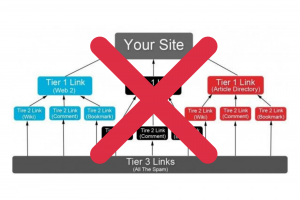Back in 2012, Google shook up the link building market with two massive actions. First, there was an enormous push to take down popular public networks. Anyone remember Build My Rank or Authority Link Network?
Then in April, they unleashed the Penguin algorithm filter and sent many SEOs running around with their hair on fire.
The Penguin algorithm was harsh. Probably too harsh to be honest. It weaponized link building. It was risky, but you could potentially get competitors penalized by throwing spammy links at them. I say it was risky because Google’s algorithm was far from perfect. You could just as easily strengthen their position as harm it.
While the Penguin algorithm did a great job in many cases of punishing sites using low quality links, there were also a lot of innocent sites caught in the mix or sites who had hired an SEO not understanding that they used spammy link building.
As a result, Google released it’s Disavow Tool in October of that year.
Fun fact: Did you know that Bing actually released a Disavow Tool before Google? Yep. Bing’s came out in September of 2012.
Since it’s release, people have debated its use. Early on, many of us cautioned against using it. Google generally does not tell you which links they have flagged as bad, except in some cases of manual penalties where they may give you a few examples.
Overuse can actually hurt your rankings.
(Some of us also suggested caution because we saw it as Google crowdsourcing to fix a problem they couldn’t figure out on their own. Basically they were saying, “Hey, why don’t you tell us which links are bad that you have been building? In exchange, here is a get out of jail free card.”
I think our concerns were valid. A couple of years ago Google announced that they can pretty well identify bad links on their own now and just ignore them. Where do you think the data came from to train their AI and machine learning algorithms to do that?)
Matt Cutts made a great analogy for how to use the tool. I’m paraphrasing, but he said you should use it like a scalpel, not a machete.
There are only two cases where you should use the Disavow Tool.
The first case is when you have received a manual penalty from Google related to link building. If this happens, you should try to actually have the offending links removed by those websites and fall back on the Disavow Tool for the ones you cannot get removed.
The second case where you should use the Disavow Tool is when you see a massive drop in rankings AND you have seen some low quality links starting to pile up or maybe there was a recent influx of low quality links.
If you have a page or pages hit by the Penguin filter because of bad links, you won’t see slight ranking drops. If you see drops of just a few spots, it’s not your links. You won’t drop from #1 to #3. You will see something more like drops of 50 spots or more. Sometimes you will drop out of the top 100 completely.
In these cases, again, the best solution is to try to get links removed, but in cases involving hundreds or thousands of spammy links coming in, that will probably not work.
You can use the Disavow Tool.
How do you know which links to disavow?
Well, Semrush has a great Toxicity filter you can look at, but do not just disavow all links it identifies as ‘toxic’. Use this filter as an indicator for links you should take a look at yourself.
Only disavow links you have manually inspect yourself.
Do not use 3rd party metrics like DA to identify low quality links. DA has nothing to do with the quality of a link (nor does any other 3rd party metric). If anything, those metrics are trying to give you a gauge for the potential strength of a link. Strength and quality are not the same thing.
How do you recognize low quality or spammy links? Well, it’s a lot like United States Supreme Court Justice Potter Stewart famously said about pornography, “I know it when I see it.”
Is the content a jumbled mess? Is the link and content at all relevant to what you do? Does the page even load? In short, if a prospect who had never heard of you came across the page and saw your link, would it hurt your brand image? Would you be embarrassed to be mentioned on that page?
I consider links like blog comments, forum posts, social bookmarks, document sharing sites, and all insignificant wikis to be spam worth disavowing too.
Lastly, if you do decide to disavow links, remember that your disavow file is kind of a living document. When you upload a file, it replaces the old one. The Disavow Tool does not store the old data. If you decide to disavow additional links, you should keep adding on to the same document and upload that file.


